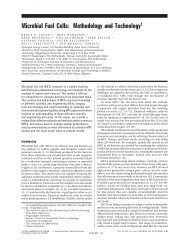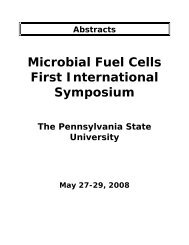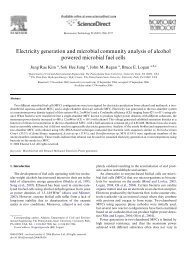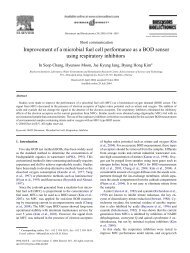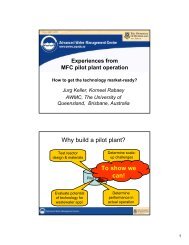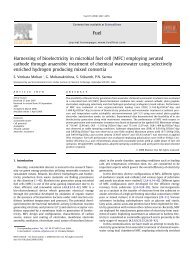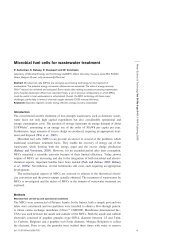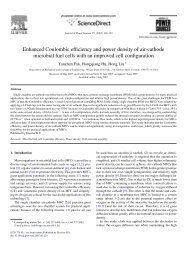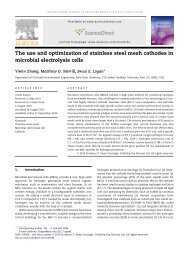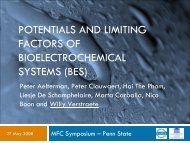Microbial Fuel Cells Generating Electricity from Rhizodeposits of ...
Microbial Fuel Cells Generating Electricity from Rhizodeposits of ...
Microbial Fuel Cells Generating Electricity from Rhizodeposits of ...
Create successful ePaper yourself
Turn your PDF publications into a flip-book with our unique Google optimized e-Paper software.
Environ. Sci. Technol. XXXX, xxx, 000–000<br />
<strong>Microbial</strong> <strong>Fuel</strong> <strong>Cells</strong> <strong>Generating</strong><br />
<strong>Electricity</strong> <strong>from</strong> <strong>Rhizodeposits</strong> <strong>of</strong><br />
Rice Plants<br />
LIESJE DE SCHAMPHELAIRE, †<br />
LEEN VAN DEN BOSSCHE, †<br />
HAI SON DANG, † MONICA HÖFTE, ‡<br />
NICO BOON, † KORNEEL RABAEY, § AND<br />
WILLY VERSTRAETE* ,†<br />
Laboratory <strong>of</strong> <strong>Microbial</strong> Ecology and Technology (LabMET)<br />
and Laboratory <strong>of</strong> Phytopathology, Ghent University, Coupure<br />
Links 653, B-9000 Ghent, Belgium, and The Advanced Water<br />
Management Centre, University <strong>of</strong> Queensland,<br />
St Lucia QLD 4072, Australia<br />
Received August 03, 2007. Revised manuscript received<br />
January 14, 2008. Accepted January 22, 2008.<br />
Living plants transport substantial amounts <strong>of</strong> organic material<br />
into the soil. This process, called rhizodeposition, provides<br />
the substrate for the rhizospheric microbial community. In this<br />
study, a laboratory-scale sediment microbial fuel cell, <strong>of</strong><br />
which the anode is positioned in the rhizosphere <strong>of</strong> the rice<br />
plants, is used to microbially oxidize the plant-derived organics.<br />
An electrical current was generated through the in situ<br />
oxidation <strong>of</strong> rhizodeposits <strong>from</strong> living rice plants. The electrical<br />
power output <strong>of</strong> a sediment microbial fuel cell was found to<br />
be a factor 7 higher in the presence <strong>of</strong> actively growing plants.<br />
This process <strong>of</strong>fers the potential <strong>of</strong> light-driven power<br />
generation <strong>from</strong> living plants in a nondestructive way.<br />
Sustainable power productions up to 330 W ha -1 could be<br />
attributed to the oxidation <strong>of</strong> the plant-derived compounds.<br />
Introduction<br />
Plants continuously provide an input <strong>of</strong> organic matter to<br />
the soil throughout their plant life. As plants decay, dead<br />
roots and shoot residues remain in the soil. During the<br />
growing season, organic carbon enters the soil as rhizodeposits<br />
(1). The latter comprise several groups <strong>of</strong> organics<br />
such as (i) water-soluble, low molecular weight, and passively<br />
lost exudates, (ii) secretions which are <strong>of</strong> high molecular<br />
weight and actively lost, (iii) lysates <strong>from</strong> sloughed-<strong>of</strong>f cells<br />
and decaying roots, (iv) gases, and (v) mucilage covering<br />
roots (2). Moreover, rhizodeposition also comprises the C<br />
flux that is directed out <strong>of</strong> roots through symbiotic mycorrhizal<br />
fungi, which are associated with over 80% <strong>of</strong> the plants<br />
(3). Since it is difficult to experimentally distinguish exudates<br />
<strong>from</strong> other rhizodeposits, root exudates are <strong>of</strong>ten defined as<br />
all organic substances released by healthy and intact roots<br />
into the environment. They comprise a gathering <strong>of</strong> carbohydrates,<br />
amino acids, amides, aliphatic acids, aromatic acids,<br />
fatty acids, sterols, enzymes, hormones, vitamins, and others<br />
(2). The release <strong>of</strong> exudates plays an important role in nutrient<br />
acquisition (4).<br />
* Corresponding author phone: 0032 9 264 59 76; fax: 0032 9 264<br />
62 48; e-mail: Willy.Verstraete@UGent.be.<br />
† LabMET, Ghent University.<br />
‡ Laboratory <strong>of</strong> Phytopathology, Ghent University.<br />
§ University <strong>of</strong> Queensland.<br />
In rice paddies, rhizodeposition counts for 200 kg organic<br />
C ha -1 crop cycle -1 (5). In a flooded rice system, this<br />
substantial input <strong>of</strong> organic material is transformed into<br />
methane to the extent that rice agriculture worldwide<br />
contributes 7-20% <strong>of</strong> the total methane emissions (6).<br />
Rhizodeposition was shown to be the main origin <strong>of</strong> methane<br />
evolution in rice paddies, with a share <strong>of</strong> 25% <strong>from</strong> exudates<br />
and 75% <strong>from</strong> decomposing root residues (5). Next to being<br />
a source <strong>of</strong> greenhouse gases, these rhizospheric processes<br />
also represent a significant loss <strong>of</strong> energy <strong>from</strong> the rice system:<br />
rice plants lose substantial amounts <strong>of</strong> trapped solar energy<br />
as rhizodeposition, while the gaseous end product <strong>of</strong> the<br />
anaerobic composition there<strong>of</strong>, methane, has a high energetic<br />
value. It would most certainly be interesting to recuperate<br />
this flow <strong>of</strong> energy <strong>from</strong> living plants, as it represents a true<br />
source <strong>of</strong> green energy. In this research, the latter was<br />
attempted through the installation <strong>of</strong> a so-called sediment<br />
microbial fuel cell (SMFC) in the rhizosphere <strong>of</strong> the rice plants.<br />
A SMFC is a microbial fuel cell, with an anode buried in<br />
a reduced matrix and a cathode floating in the overlying,<br />
oxidized water layer (7). The submerged matrix can serve as<br />
a support for plant growth; it can be composed <strong>of</strong> various<br />
types <strong>of</strong> materials. At the anode, a microbially catalyzed<br />
oxidation <strong>of</strong> reduced compounds is responsible for a delivery<br />
<strong>of</strong> electrons to the anodic electrode. The electrons pass<br />
through an electrical circuit, containing a power user. Arriving<br />
at the cathodic electrode, they react with the available electron<br />
acceptor, such as oxygen. A microbial fuel cell in general is<br />
thus able to extract electrical power <strong>from</strong> the oxidation <strong>of</strong><br />
bioconvertible substrates (8). Thus far, research on SMFCs<br />
primarily involved marine SMFCs and typically resulted in<br />
sustained power productions <strong>of</strong> 9-16 mW m -2 total anodic<br />
surface (7, 9, 10).<br />
The rice rhizodeposits potentially form substrates for an<br />
SMFC. This research aims to exploit this flow <strong>of</strong> energy by<br />
oxidizing the substrates derived <strong>from</strong> living plants directly<br />
at an anode. The purpose is to demonstrate that growing<br />
plants can serve as ongoing sources <strong>of</strong> organic substrates for<br />
power generation in a SMFC configuration. To achieve this<br />
goal, several SMFC reactors were set up, comprising reactors<br />
with and without plants, operated in open and closed<br />
electrical circuit and with several types <strong>of</strong> substratum, namely,<br />
soil, vermiculite, and graphite granules.<br />
Materials and Methods<br />
Growth <strong>of</strong> Rice Plants. Rice plants used in the experiments<br />
belonged to Oryza sativa ssp. indica, cultivar C101PKT,<br />
originating <strong>from</strong> the International Rice Research Institute.<br />
After 1 week humid incubation <strong>of</strong> the rice seeds at 28 °C and<br />
3 weeks growth in soil or vermiculite, the plants were<br />
transplanted into containers equipped with electrodes and<br />
further referred to as sediment microbial fuel cell (SMFC)<br />
reactors. Nutrients were dosed at a rate <strong>of</strong> 5 g <strong>of</strong> (NH 4 ) 2 SO 4<br />
m -2 week -1 and 10 g <strong>of</strong> FeSO 4 · 7H 2 Om -2 week -1 with soil as<br />
support layer, while plants growing in vermiculite were fed<br />
with Hoagland’s hydroponics solution (11) every 2 or 3 days.<br />
During operation <strong>of</strong> the SMFC reactors in soil and vermiculite,<br />
a regular administering <strong>of</strong> nutrients was only applied during<br />
the first 3 weeks <strong>of</strong> reactor runs and during 3 weeks around<br />
day 150 <strong>of</strong> the reactor runs. No nutrients were given to the<br />
plants in reactors with graphite granules. The omission <strong>of</strong><br />
nutrients was intended to stimulate root exudation (4).<br />
Trials during the Summer <strong>of</strong> 2006: Construction. For<br />
the first two series <strong>of</strong> SMFC reactors (see Figure 1), plastic<br />
containers with an upper area or plant growth area (PGA) <strong>of</strong><br />
272.25 cm 2 and a total volume <strong>of</strong> 4.6 L were filled with either<br />
10.1021/es071938w CCC: $40.75 © XXXX American Chemical Society VOL. xxx, NO. xx, XXXX / ENVIRONMENTAL SCIENCE & TECHNOLOGY 9 A<br />
Published on Web 03/18/2008
FIGURE 1. Schematic representation <strong>of</strong> the reactor setup. Each<br />
<strong>of</strong> the four separated compartments holds a so-called sediment<br />
microbial fuel cell (SMFC): a support matrix in which plants<br />
can root and which holds one or more anodes is submerged by<br />
water in which a cathode is placed. The SMFC can be planted<br />
or not. The support matrix can be, e.g., regular soil, vermiculite,<br />
etc. In the case <strong>of</strong> soil as matrix, the reactors presented above<br />
are respectively called soil 0 (control reactor in closed circuit,<br />
without plants), soil 1 (reactor in closed circuit, with plants),<br />
soil 2 (repetition <strong>of</strong> soil 1 ), and soil OC (reactor in open circuit,<br />
with plants).<br />
soil (Structural Pr<strong>of</strong>essional type 1, M. Snebbout N.V.,<br />
Kaprijke, Belgium) or vermiculite (exfoliated vermiculite, Sibli<br />
SA Vermiculite et Perlite, Andenne, Belgium) as supports for<br />
plant growth. These containers were placed in subdivided<br />
aquaria filled with tap water to a height <strong>of</strong> 25 or 8 cm above<br />
the support surface, thus leading to a total volume <strong>of</strong> 13.3<br />
L/(microbial fuel cell). Before placement, two anodic graphite<br />
mats (3.18 mm thickness, Alfa Aesar) <strong>of</strong> 9 cm by 12 cm were<br />
placed in the support layers, one at 6 cm and one at 14 cm<br />
below the support surface, resulting in a total anodic<br />
geometric area (GA) <strong>of</strong> 216 cm 2 . Only one anode <strong>of</strong> 6 cm by<br />
9 cm was placed at a depth <strong>of</strong> 6 cm below the surface in<br />
reactors meant for open circuit (no current harvesting was<br />
required). All mats were interwoven with a graphite rod (5<br />
mm diameter, Morgan), which was attached to the electrical<br />
circuitry through an insulated connection. The third series<br />
<strong>of</strong> reactors consisted <strong>of</strong> glass cylinders with a diameter <strong>of</strong> 14<br />
cm, filled with 11.5 cm <strong>of</strong> graphite granules (5 mm diameter,<br />
Le Carbon), a sand layer <strong>of</strong> 1.5 cm, and a standing water<br />
layer <strong>of</strong> 5 cm. The anodic structure as a whole had a geometric<br />
area, equal to the plant growth area, <strong>of</strong> 154 cm 2 . A graphite<br />
rod <strong>of</strong> 13 cm and insulated wire connected the anodic granule<br />
matrix to the outside. Four plants grown in soil were planted<br />
in the containers filled with soil, while respectively 6 and 2<br />
plants grown in vermiculite were planted in the containers<br />
filled with vermiculite and cylinders with granules. Control<br />
reactors were unplanted. Bacterial inocula were added to all<br />
anodic compartments, by injecting all reactors with 10 mL<br />
<strong>of</strong> the effluent <strong>of</strong> an acetate oxidizing MFC reactor (12). Soil<br />
and vermiculite matrices were furthermore initially mixed<br />
with 20 mL <strong>of</strong> a methanogenic culture (presettling tank <strong>of</strong><br />
a constructed wetland, Wontergem, Belgium).<br />
Two types <strong>of</strong> cathodes were used. The first type consisted<br />
<strong>of</strong> a tube <strong>of</strong> cation exchange membrane (Ultrex), closed at<br />
the bottom (diameter, 3.4 cm; length, 20 cm). These tubes<br />
were filled with graphite granules, a regularly replenished<br />
100 mM phosphate buffered solution <strong>of</strong> 100 mM K 3 Fe(CN) 6 ,<br />
and a graphite rod for electrical contact. This type <strong>of</strong> cathode<br />
was used for the reactors with graphite granules at the anode<br />
(except for gran OC , which did not contain a cathode) and<br />
during the first 100 and 125 days respectively <strong>of</strong> the test runs<br />
<strong>of</strong> reactors with soil and vermiculite. During the remaining<br />
time <strong>of</strong> the latter two series <strong>of</strong> reactors, a biologically catalyzed<br />
oxygen reducing cathode was used. This graphite mat cathode<br />
(5 cm by 12.5 cm) was connected with a graphite rod, floating<br />
in the top water layer <strong>of</strong> the reactors and slightly aerated<br />
through an air pump. Before placement <strong>of</strong> the cathodes, the<br />
mats were inoculated with a performant cathodic culture<br />
and the oxygen reduction reaction was initiated in separate<br />
SMFCs.<br />
Trials during the Summer <strong>of</strong> 2006: Operation. The entire<br />
reactor setup consisted <strong>of</strong> 13 SMFC reactors, 4 with soil (soil),<br />
4 with vermiculite (verm), and 5 with graphite granules (gran)<br />
as support material. To denote the different types <strong>of</strong> reactors,<br />
a subscript is added to the support abbreviation: 1 and 2 for<br />
the repetitions <strong>of</strong> the reactors with plants in closed circuit,<br />
allowing current generation (soil 1 , soil 2 , verm 1 , verm 2 , gran 1 ,<br />
and gran 2 ), 0 and 0′ for the control reactors without plants<br />
in closed circuit (soil 0 , verm 0 , gran 0 , and gran 0′ ) and OC for<br />
the reactors with plants in open circuit (soil OC , verm OC , and<br />
gran OC ), where no current is possible. Table S1 <strong>of</strong> the<br />
Supporting Information gives an overview <strong>of</strong> the different<br />
types <strong>of</strong> reactors and their names.<br />
The electrical circuits were closed through the use <strong>of</strong> a<br />
variable external resistance, which at any time had one value<br />
(between 75 and 500 Ω) per series <strong>of</strong> reactors. The reactors<br />
were positioned in a greenhouse with a temperature thermostat<br />
set at 28 °C and under special horticulture lamps<br />
(HQI, 400 W) with a 16-h-day-8-h-night cycle. On the basis<br />
<strong>of</strong> temperature and light conditions in- and outside the<br />
greenhouse, the reactor runs can be subdivided in three<br />
succeeding test periods, starting <strong>from</strong> the beginning <strong>of</strong> April<br />
2006. Average outside shortwave radiation and outside<br />
temperatures during test period 1 were 157 W m -2 (second<br />
half <strong>of</strong> this test period) and 13.2 ( 3.5 °C (inside around 30<br />
°C); during test period 2, 231 W m -2 and 20.0 ( 4.0 °C (inside<br />
around 42 °C) and during test period 3, 105 W m -2 and 16.1<br />
( 2.5 °C (with intermediate inside temperatures). Radiation<br />
inside the greenhouse was determined to be around 18 MJ<br />
m -2 day -1 during the second test period (LICOR, LI-190S,<br />
(13)). Test periods 1-3 respectively started on days 1, 52,<br />
and 120 <strong>of</strong> the soil reactor runs, on days 1, 60, and 128 <strong>of</strong> the<br />
verm reactor runs, and days 1, 2, and day 70 <strong>of</strong> the gran<br />
reactor runs. The total reactor runs <strong>from</strong> the soil and verm<br />
reactors respectively comprised 204 and 188 days, thus<br />
covering the entire cycle <strong>of</strong> the rice plant life <strong>from</strong> transplanting<br />
onward. The reactor runs <strong>from</strong> the gran reactors<br />
lasted 142 days.<br />
Trials during the Summer <strong>of</strong> 2007: Construction and<br />
Operation. One year after the operation <strong>of</strong> the three series<br />
<strong>of</strong> reactors described above, a fourth series <strong>of</strong> reactors was<br />
constructed analogous to the soil reactors. This series is<br />
referred to as b-soil reactors. The construction <strong>of</strong> the b-soil<br />
reactors differed <strong>from</strong> that <strong>of</strong> the soil reactors by the use <strong>of</strong><br />
plastic containers with an upper PGA <strong>of</strong> 231.04 cm 2 , height<br />
<strong>of</strong> 19.6 cm, and total volume <strong>of</strong> 3.3 L. Three anodic graphite<br />
mats (Sigratherm, KFA, 2.5 mm thickness), each <strong>of</strong> 6 cm by<br />
11 cm, were placed horizontally at respectively 5, 11 and 17<br />
cm below the support surface and resulted in a total anodic<br />
geometric area <strong>of</strong> 198 cm 2 . The cathode consisted in each<br />
case <strong>of</strong> an aerated graphite mat (Alfa Aesar, 3.18 mm<br />
thickness) <strong>of</strong> 5 cm by 12.5 cm. Three containers were planted<br />
with 5 4-week-old rice plants each (b-soil 1 , b-soil 2 , and b-soil 3 ),<br />
two containers remained unplanted (b-soil 0 and b-soil 0′ )<br />
(Table S1). An extra horticulture lamp (HQI, 400 W) was placed<br />
above the reactors to account for lower light influx. The<br />
reactor runs started in the beginning <strong>of</strong> June 2007 and could<br />
be divided in two test periods. The average shortwave<br />
radiation and outside temperature were respectively 166 W<br />
m -2 and 18.4 ( 3.6 °C in the first period and 78 W m -2 and<br />
13.6 ( 3.8 °C in the second test period, which started on day<br />
88 <strong>of</strong> the reactor runs. An external resistance <strong>of</strong> either 497<br />
or 100 Ω was used. Data collected until day 144 <strong>of</strong> the reactor<br />
run are included in this paper.<br />
B 9 ENVIRONMENTAL SCIENCE & TECHNOLOGY / VOL. xxx, NO. xx, XXXX
Electrochemical Data. Continuous potential measurements<br />
were recorded every 5 or 7.5 min. Other electrochemical<br />
measurements and the analysis there<strong>of</strong> were<br />
performed according to Logan et al. (14). Negative signs were<br />
assigned to power outputs corresponding with reverse<br />
(negative) currents. The expression <strong>of</strong> current production as<br />
chemical oxygen demand (COD) oxidation was based on the<br />
release <strong>of</strong> 4 mol <strong>of</strong> electrons/(mol <strong>of</strong> COD oxidized or mol<br />
<strong>of</strong> O 2 ).<br />
Chemical Analysis. Chemical oxygen demand analysis<br />
was chosen as a general measurement <strong>of</strong> the amounts <strong>of</strong><br />
oxidizable material in the solution <strong>of</strong> the anodic compartment.<br />
Mixed samples <strong>of</strong> the solution were collected with a<br />
spinal needle, stored at 4 °C, filtered (Whatman, 597 1 / 2 ) and<br />
analyzed according to the dichromate method (15). The dry<br />
weights (DW) <strong>of</strong> the rice shoots as well as the panicles were<br />
determined by drying the rice biomass overnight at 105 °C.<br />
The pooled above-ground biomass weights per reactor were<br />
divided by the initial number <strong>of</strong> plants to normalize for the<br />
different numbers <strong>of</strong> plants in reactors with vermiculite and<br />
soil.<br />
Statistical Analysis. Statistical analysis was performed<br />
on the data <strong>from</strong> Figure 4, excluding the data points <strong>from</strong><br />
verm OC to prevent biases, resulting in 14 data pairs. On the<br />
basis <strong>of</strong> the shape <strong>of</strong> the scatterplot <strong>of</strong> the data, linear, logistic,<br />
and nonlinear regressions were applied and the Pearson<br />
correlation coefficient (two-tailed) between the transformed<br />
COD concentrations and the current productions was<br />
determined. A Michaelis–Menten type <strong>of</strong> model with lateral<br />
shift [current ∼ C max (COD - X)/(K + (COD - X))] and<br />
parameters C max (maximum current) ) 2.4, K (Michaelis<br />
constant) ) 141, and X (lateral shift) ) 74 resulted in the<br />
highest correlation coefficient, being 0.76 (p ) 0.002). Normal<br />
distribution <strong>of</strong> the data sets was checked through P-P plots<br />
and the Kolmogorov–Smirnov test. Variability is expressed<br />
as standard deviation throughout the paper.<br />
Results<br />
Overall Electrochemical Performance. In the summer <strong>of</strong><br />
2006, four SMFCss<strong>of</strong> which three were planted with<br />
riceswere set up with natural soil as support and were held<br />
in open circuit (no current was allowed) until a cell potential<br />
higher than 600 mV was reached, indicating anaerobic<br />
conditions around the anode. The stable open circuit cell<br />
potential <strong>of</strong> soil OC , the control reactor with plants that was<br />
kept in open circuit throughout the experimental period,<br />
slowly increased during the entire reactor run <strong>of</strong> 204 days<br />
<strong>from</strong> 695 to 800 mV with an anodic redox potential decreasing<br />
<strong>from</strong> -240 mV vs SHE to -340 mV vs SHE. The sharpest<br />
increase in open circuit cell potential occurred concomitantly<br />
with the start <strong>of</strong> the second test period, with a stronger sun<br />
regime. Notable currents <strong>of</strong> about 3 mA m -2 anodic geometric<br />
area (GA) were harvested <strong>from</strong> the moment the electrical<br />
circuits <strong>of</strong> reactors soil 1 and soil 2 (with plants) and soil 0<br />
(without plants) were closed. A steady relation between the<br />
subsequent, higher level performances <strong>of</strong> these reactors was<br />
only observed <strong>from</strong> the start <strong>of</strong> the second test period onward.<br />
Figure S1a <strong>of</strong> the Supporting Information contains a simplified<br />
performance pr<strong>of</strong>ile <strong>of</strong> the soil reactors through time,<br />
representing the cumulative electron transfer.<br />
Averaged over the entire period <strong>of</strong> closed circuit, soil 1 ,<br />
soil 2 , and soil 0 respectively delivered 68 ( 45, 54 ( 38, and<br />
40 ( 20 mA m -2 GA. When averaging over concurrent, stable,<br />
and representative periods (not limited by the cathode<br />
reaction, plant age, or climate), comprising at least 27 days<br />
per reactor (between day 63 and day 129), the reactors with<br />
plants in soil produced a current <strong>of</strong> 120 ( 19 mA m -2 GA,<br />
which is a factor 2.7 higher than the current <strong>of</strong> 44 ( 8mA<br />
m -2 GA, produced by the reactor with soil. During that period,<br />
the reactors with plants produced a factor 7 more power<br />
FIGURE 2. Electrical power output per m 2 geometric anode area<br />
(GA) and standard deviation. (a) First three series <strong>of</strong> reactors,<br />
operated in the summer <strong>of</strong> 2006. At the left side <strong>of</strong> the figure,<br />
power output is given for periods with a ferricyanide cathode<br />
(cross-hatched bars) and with an oxygen reducing cathode<br />
(black bars). The right side only refers to periods with<br />
ferricyanide cathodes. A subscript 0 points to the absence <strong>of</strong><br />
plants. Each bar depicts a representative performance period<br />
per reactor, comprising a period <strong>of</strong> respectively 16, 15, and 5<br />
days or more in case <strong>of</strong> reactors with soil (soil), vermiculite<br />
(verm), and graphite granules (gran). The cross-hatched bars<br />
<strong>from</strong> soil and vermiculite reactors originated <strong>from</strong> test period 2;<br />
all other bars, <strong>from</strong> test period 3. (b) Repetition series with soil<br />
(b-soil), operated during the summer <strong>of</strong> 2007. The bars depict<br />
representative performance periods <strong>of</strong> at least 18 days. At any<br />
instance, an oxygen reducing cathode was used. A subscript 0<br />
points to the absence <strong>of</strong> plants.<br />
than the control reactor without plants, being 26 ( 7mW<br />
m -2 GA versus 3.7 ( 1.8 mW m -2 GA (Figure 2a; Figure S2<br />
and Table S2 <strong>of</strong> the Supporting Information).<br />
A similar reactor setup was used with vermiculite as<br />
support. These SMFCs were held in open circuit for 29 days,<br />
during which the obtained open circuit cell potentials<br />
remained fluctuating with daily peaks between -50 and +130<br />
mV. At the start <strong>of</strong> test period 2 (day 60), the cell potentials<br />
<strong>of</strong> the reactors with plants started to increase steeply to reach<br />
higher and more stable values: the open circuit cell potential<br />
<strong>of</strong> verm OC , the control reactor with plants that was kept in<br />
open circuit throughout the experimental period, reached<br />
consistently positive values up to 760 mV, verm 1 increased<br />
its cell potential with a factor 15 and verm 2 changed its<br />
regularly negative cell potential into a stable positive cell<br />
potential. It required 104 dayssstill in test period 2sfor verm 2<br />
to steeply increase its cell potential to become as high as that<br />
<strong>of</strong> verm 1 . During periods with high cell potentials, a fluctuation<br />
in the latter could also be observed, this time without<br />
negative cell potentials (Figure 3). These fluctuations were<br />
determined by the anodic potentials; high cell potentials and<br />
low anodic potentials were reached when light conditions<br />
prevailed and low cell potentials and high anodic potentials<br />
were reached in the absence <strong>of</strong> light. The closed circuit reactor<br />
without plants (verm 0) demonstrated low cell potentials (with<br />
a negative average) during the entire reactor run. The<br />
VOL. xxx, NO. xx, XXXX / ENVIRONMENTAL SCIENCE & TECHNOLOGY 9 C
FIGURE 3. Fluctuation in voltage produced in reactors<br />
containing vermiculite and plants. Vertical bars show the<br />
artificial light conditions inside the greenhouse (grey bars ) no<br />
light). The external resistance for the reactor in closed circuit<br />
was 495 Ω, and a ferricyanide type <strong>of</strong> cathode was used. Dark<br />
line, verm OC ; light line, verm 1 .<br />
FIGURE 4. Anodic organic substrate <strong>of</strong> the reactors with<br />
vermiculite as support layer. Current production, expressed as<br />
rate <strong>of</strong> COD oxidation per day and per liter total anode<br />
compartment (TAC), is plotted versus COD concentration<br />
measured in the anodic solution. Reactors with plants in closed<br />
circuit (b, verm 1 ; O, verm 2 ) and with plants in open circuit<br />
(2, verm OC ) are presented.<br />
cumulative electron transfer <strong>of</strong> the three reactors with<br />
vermiculite support in closed circuit is given in Figure S1b.<br />
Although there was variability in the length <strong>of</strong> the start-up<br />
period, the reactors with plants clearly behaved similar to<br />
each other and differed <strong>from</strong> the reactor without plants, which<br />
produced low negative currents.<br />
The total time-averaged current production <strong>of</strong> verm 1 ,<br />
verm 2 , and verm 0 was respectively 36 ( 17, 14 ( 16, and -0.7<br />
( 1.0 mA m -2 GA. The mean current averaged over total<br />
representative periods <strong>of</strong> at least 38 days per reactor (between<br />
day 54 and day 188) gives 44 ( 9mAm -2 GA for the reactors<br />
with rice (verm 1 and verm 2 ) and -0.56 ( 0.69 mA m -2 GA<br />
for the reactor without rice plants (verm 0 ). The mean power<br />
for verm 1 and verm 2 was 21 ( 8mWm -2 GA; that <strong>of</strong> verm 0<br />
was -0.008 ( 0.01 mW m -2 GA (Figure 2a and Table S2).<br />
Verm 1 could sustain a power production <strong>of</strong> 33 mW m -2 GA<br />
for at least 6 days.<br />
A third series <strong>of</strong> reactors contained graphite granules as<br />
plant support. These SMFCs generally yielded low cell<br />
potentials, as was the case with the vermiculite reactors. Near<br />
the end <strong>of</strong> the reactor runs, current production <strong>from</strong> the<br />
reactors with plants (gran 1 and gran 2 ) started to increase<br />
steeply, whereas that <strong>of</strong> the reactors without plants (gran 0<br />
and gran 0′ ) did not. By subtracting the cumulative electron<br />
transfer <strong>of</strong> the last type <strong>of</strong> reactor <strong>from</strong> the first one, the net<br />
cumulative electron transfer could be obtained (Figure S1c).<br />
Averaging power production over a high-performance period<br />
<strong>of</strong> a minimum <strong>of</strong> 5 days per reactor (between day 119 and<br />
day 141) yielded 15.8 ( 2.1 mW m -2 GA for the granule<br />
reactors with plants and 0.14 ( 0.03 mW m -2 GA for those<br />
without plants (Figure 2a).<br />
To confirm the test results and show that repetition in<br />
time was possible, an additional series <strong>of</strong> reactors was set up<br />
during the summer 1 year later, with soil as support layer<br />
(b-soil reactors). The cumulative electron transfer for these<br />
reactors is shown in Figure S1d. Averaged over the entire<br />
reactor run the reactors b-soil 1 , b-soil 2 , b-soil 3 , b-soil 0 , and<br />
b-soil 0′ respectively produced 43 ( 30, 35 ( 27, 39 ( 23, 22<br />
( 17, and 7 ( 12 mA m -2 GA. The mean current production<br />
during a representative period <strong>of</strong> at least 18 days (between<br />
day 62 and day 85) was a factor 3.4 higher for the reactors<br />
with plants (b-soil 1 , b-soil 2 , and b-soil 3 ) than for those without<br />
plants (b-soil 0 and b-soil 0′ ), being 68 ( 20 versus 20 ( 12 mA<br />
m -2 GA. The mean power output for the reactors with plants<br />
was 9.9 ( 6.0 mW m -2 GA, which was a factor 9 higher than<br />
the power output <strong>from</strong> the reactors without plants (1.1 ( 1.1<br />
mW m -2 GA) (Figure 2b; Figure S2 and Table S2). This<br />
confirmed the observations <strong>of</strong> the previous summer.<br />
Energy Considerations. The energy obtained through the<br />
planted SMFC systems can be compared with the energy<br />
cycle <strong>of</strong> irradiant solar energy, photosynthesis, and exudation.<br />
An extended version <strong>of</strong> these calculations can be found in<br />
the Supporting Information. On the basis <strong>of</strong> the actual rice<br />
biomass production in these experiments and a release <strong>of</strong><br />
3% as exudates, an exudate release <strong>of</strong> 0.41 g <strong>of</strong> C m -2 PGA<br />
day -1 was obtained. Considering a general composition <strong>of</strong><br />
[CH 2 O] for the released material, this can be converted in a<br />
daily release <strong>of</strong> electrons and energy. The averaged current<br />
and power production <strong>from</strong> the SMFCs, which could be<br />
attributed to the plants, was 47.5 and 17 mW m -2 PGA,<br />
corresponding with 0.043 mol <strong>of</strong> electrons and 1.47 kJ m -2<br />
PGA day -1 . On the basis <strong>of</strong> the biomass production and the<br />
oxidation <strong>of</strong> the readily biodegradable theoretical exudate<br />
release, the SMFCs with rice plants thus obtain a coulometric<br />
efficiency (recovery <strong>of</strong> electrons) <strong>of</strong> 31% and an energetic<br />
efficiency <strong>of</strong> 9%. Through a combination <strong>of</strong> the sunlight<br />
interception efficiency (89%; based on LAI), the photosynthetic<br />
efficiency for C 3 plants (4.9%), the exudates release<br />
(3%), and the fuel cell efficiency (9%), an overall efficiency<br />
for the conversion <strong>of</strong> light energy into electrical energy is<br />
obtained, being 0.01%. This can be confirmed by comparing<br />
the harvested 1.47 kJ m -2 PGA day -1 with the radiation energy<br />
in the greenhouse (about 18 MJ m -2 day -1 , the same order<br />
<strong>of</strong> magnitude as the solar radiation <strong>of</strong> 15 MJ m -2 day -1 in rice<br />
producing countries).<br />
Rice Plants and the Anodic Organic Substrate. Measurements<br />
<strong>of</strong> soluble COD in the interstitial anodic solution<br />
<strong>of</strong> reactors with vermiculite as support were taken as a<br />
representative for the amount <strong>of</strong> reduced organics available<br />
as microbial substrate at the anode, as this forms the source<br />
<strong>of</strong> electrical energy in the systems. Higher COD concentrations<br />
could be measured in verm 1 than verm 2 . The first reactor<br />
generally performed better <strong>from</strong> an electrical point <strong>of</strong> view<br />
than the latter. There was more COD in solution in reactors<br />
producing current than in the reactor left in open circuit<br />
(see Figure S3 in the Supporting Information for CODcentrations<br />
through time). Figure 4 demonstrates a positive<br />
Michaelis–Menten-like correlation between the current<br />
production in the vermiculite reactors and the COD concentration<br />
in the anodic compartment. This type <strong>of</strong> correlation<br />
might imply that the attainable current output is<br />
limited for the used setup.<br />
At the end <strong>of</strong> the reactor runs, the aboveground biomass<br />
mainly consisted <strong>of</strong> senescent leaves, suggesting that decaying<br />
plant material could be an important anodic substrate at<br />
this point. This was especially the case with the reactors in<br />
D 9 ENVIRONMENTAL SCIENCE & TECHNOLOGY / VOL. xxx, NO. xx, XXXX
graphite granules, where the electrical current production<br />
(Figure S1c) notably increased after the plants had almost<br />
died <strong>of</strong>f. The reason for this plant mortality presumably was<br />
a visible leakage <strong>of</strong> traces <strong>of</strong> ferricyanide <strong>from</strong> the cathode<br />
into the anode compartment, since the plants in gran OC (open<br />
circuit without a ferricyanide cathode) remained healthy<br />
(results not shown).<br />
The total aboveground production <strong>of</strong> plant biomass was<br />
determined at the end <strong>of</strong> the soil and verm reactor runs.<br />
With an overall production <strong>of</strong> 27 ( 7 g <strong>of</strong> DW/(plant in closed<br />
circuit) and 21 ( 1 g <strong>of</strong> DW/(plant in open circuit), there<br />
appears to be no effect <strong>of</strong> the electrical circuit on the plant<br />
biomass production.<br />
Discussion<br />
In this study it was demonstrated that the presence <strong>of</strong> plants<br />
increased the power production <strong>from</strong> sediment microbial<br />
fuel cells (SMFCs) (see also Figure 2, Figure S2, and Table S2)<br />
and that it is possible to oxidize plant-derived material in<br />
situ. A reactor with soil as support, holding organic oxidizable<br />
substrate, enabled a freshwater SMFC to produce electrical<br />
power in a sustained way. The presence <strong>of</strong> plants increased<br />
the current output <strong>from</strong> this type <strong>of</strong> reactor with a factor 2.7<br />
and the power output with a factor <strong>of</strong> 7. The series <strong>of</strong> 2007,<br />
only using soil as support, showed that our data were<br />
reproducible during a subsequent summer period. Differences<br />
in absolute values and trends between the two soil<br />
series are probably related to differences in plant growth<br />
and age, time <strong>of</strong> reactor run, and weather which indeed<br />
slightly varied between the two experimental years. If the<br />
reactors were filled with a support matrix, which did not<br />
contain organic material, being vermiculite (hydroponic plant<br />
growth substratum) or graphite granules (anodic matrix for<br />
reactor type MFCs), no apparent electrical current could be<br />
produced in the absence <strong>of</strong> plants. The presence <strong>of</strong> plants,<br />
more specifically the presence <strong>of</strong> living plant roots around<br />
the anode, allowed substantial power generation. Roots <strong>of</strong><br />
living plants transport organic material such as exudates into<br />
the rhizosphere. As exudates have a major stimulatory effect<br />
on microbial growth and activity because <strong>of</strong> their rapid<br />
assimilation (2), they indeed qualify as a readily oxidizable<br />
anodic substrate. The highest sustained electrical output,<br />
based on plant-derived material, was an output <strong>of</strong> 33 mW<br />
m -2 GA or 330 W ha -1 GA.<br />
On the basis <strong>of</strong> the oxidation <strong>of</strong> theoretical exudate release,<br />
the SMFCs with rice plants obtained a coulometric efficiency<br />
<strong>of</strong> 31% and an energetic efficiency <strong>of</strong> 9%. Further engineering<br />
improvements on the system are necessary to enable an<br />
increase in fuel cell efficiency. The results <strong>from</strong> Figure 2a<br />
demonstrate that the electrical output <strong>from</strong> a system with<br />
ferricyanide at the cathode (used before in reactor type MFCs<br />
for a reliable output (12)) was at equivalent levels as that<br />
<strong>from</strong> a system with a sustainable, biologically catalyzed<br />
cathode, using dissolved oxygen as cathodic reagent.<br />
The electrical current and power produced in the SMFCs<br />
in this study can be compared with the power obtained in<br />
previous SMFC research, with a similar design but different<br />
substrates. A long-term sustained current and power production<br />
<strong>of</strong> 120 mA m -2 GA (geometric anode area) or 56 mA<br />
m -2 AS (total anodic electrode surface) and 26 mW m -2 GA<br />
or 12 mW m -2 AS was obtained in this work <strong>from</strong> a rice<br />
freshwater ecosystem. Long-term sustained current and<br />
power production <strong>from</strong> marine systems amounted to 34 mA<br />
m -2 AS (7) and 16 mW m -2 AS (9). Reimers et al. (16) reached<br />
a power output (sustainable for 24 h) <strong>of</strong> about a factor 2<br />
higher at an ocean seep. Sustained electrical production <strong>from</strong><br />
a sediment freshwater system amounted to 9 mA m -2 AS<br />
(17). Power production is more difficult to obtain <strong>from</strong><br />
freshwater systems than <strong>from</strong> salt water systems because <strong>of</strong><br />
a lower electric conductivity and decreased reactivity <strong>of</strong> the<br />
electrodes. Hence, the long-term sustained results obtained<br />
in this (freshwater) study are substantial.<br />
During the trials in 2006, a start-up period <strong>of</strong> 50-100 days<br />
was required in order for the reactors to start producing<br />
electrical current derived <strong>from</strong> living plants (Figure S1). The<br />
time delay could be due to many reasons, such as the life<br />
cycle dependency <strong>of</strong> the exudate release, both qualitatively<br />
and quantitatively (2, 18), the omission <strong>of</strong> nutrients (which<br />
can induce exudation) (4), the release <strong>of</strong> oxygen, conducted<br />
through the aerenchyma (19), scavenging the electrons<br />
otherwise collected at the anode, and the lack <strong>of</strong> an adapted<br />
anodic microbial consortium. Temperature and light conditions<br />
are an important factor, as the onset <strong>of</strong> high voltages<br />
<strong>of</strong> the plant reactors coincided for most reactors with the<br />
start <strong>of</strong> test period 2, with higher temperatures and higher<br />
photosynthetic radiation. Higher phototrophic production<br />
allows a higher exudate release, while high temperatures have<br />
been reported to decrease the oxygen release by plants (20)<br />
as well as increase the exudate release (2). The vermiculite<br />
reactor without plants was not affected by the periods <strong>of</strong><br />
high ambient temperature. Temperature and photosynthetic<br />
radiation were higher at the onset <strong>of</strong> the trials in 2007 than<br />
at the onset in 2006, which could explain the earlier onset<br />
<strong>of</strong> stable trends in 2007. The fluctuations in cell potential <strong>of</strong><br />
reactors with plants, determined by the anodic potentials<br />
(as the cathodic potentials were relatively stable, Figure 3),<br />
were presumably due to the presence <strong>of</strong> reduced, oxidizable<br />
compounds around the anode. The release <strong>of</strong> the latter is<br />
higher during the day, as demonstrated by Leake et al. (3).<br />
A relatively higher concentration <strong>of</strong> reduced compounds<br />
would result in a lower anodic potential and hence a higher<br />
cell potential during the day. Photosynthesis thus determines<br />
the cell potential <strong>of</strong> the fuel cells and the power that can be<br />
extracted <strong>from</strong> these reactors.<br />
The positive relationship between COD and current<br />
production (Figure 4) demonstrates that the COD derived<br />
<strong>from</strong> the plants (representing rhizodeposition) acts as an<br />
electron donor for electricity generation. The presence <strong>of</strong> an<br />
oxidizing anode leads to higher concentrations <strong>of</strong> COD<br />
(Figure 4). The latter infers that the withdrawal <strong>of</strong> rhizodeposits<br />
appears to stimulate a further excretion <strong>of</strong> reduced<br />
substrates by the roots. This is in accordance with the findings<br />
<strong>of</strong> Barber and Lynch (21), who found an increased exudation<br />
in the presence <strong>of</strong> microorganisms, possibly through the<br />
utilization <strong>of</strong> exudates. Attempts to characterize the substances<br />
comprising the measured COD are warranted. The<br />
rice plants studied in our reactors produced current during<br />
thousands <strong>of</strong> hours <strong>of</strong> their plant life. A large part <strong>of</strong> this was<br />
during an active growth period, suggesting that excreted<br />
compounds, mucilage, and sloughed-<strong>of</strong>f cells, etc. made up<br />
the anodic substrate, aside <strong>from</strong> the oxidation <strong>of</strong> dead plant<br />
material. The latter would notably occur at the end <strong>of</strong> the<br />
reactor runs, when the aboveground biomass mainly consisted<br />
<strong>of</strong> senescent leaves. The fact that current can be<br />
obtained <strong>from</strong> the oxidation <strong>of</strong> decomposing root residues<br />
is in accordance with the observation that root residues are<br />
the major contributor to methane production (5).<br />
Photosynthetic activity has been applied before to drive<br />
the electricity generation in reactor type MFCs, involving<br />
whole-cell photosynthetic microorganisms or subcellular<br />
photosynthetic components and requiring either electrocatalyzed<br />
anodes or the addition <strong>of</strong> redox mediators (22, 23).<br />
This paper demonstrated for the first time that living higher<br />
plants can provide an ongoing supply for electrical current<br />
production in a sediment type <strong>of</strong> microbial fuel cell, without<br />
the need for chemical catalysts or added redox mediators.<br />
The anodic oxidation <strong>of</strong> organic compounds set free by plant<br />
roots into the rhizosphere <strong>of</strong>fers several environmental<br />
perspectives. A rice paddy field or any vegetated wetland<br />
VOL. xxx, NO. xx, XXXX / ENVIRONMENTAL SCIENCE & TECHNOLOGY 9 E
system could thus for instance give rise to a renewable<br />
resource for direct electricity production by oxidizing a<br />
substrate, which is conventionally transformed into methane.<br />
A potential is <strong>of</strong>fered for a sun-driven power generation in<br />
(remote) areas with high solar inputs without the need for<br />
scarce and costly construction materials such as silicon used<br />
to fabricate photovoltaic cells. This nondestructive energy<br />
production <strong>from</strong> biomass occurs without the need <strong>of</strong> costly<br />
and/or energy consuming conversion techniques. Whereas<br />
a typical sediment MFC is furthermore limited by diffusion<br />
to the anode, a living plant can continuously deliver substrate<br />
close to the anode, allowing continuous power production<br />
and increasing the attainable production <strong>from</strong> a typical<br />
nonplanted SMFC. Alternatively, this type <strong>of</strong> SMFC might be<br />
applied to influence redox-dependent processes in the<br />
rhizosphere. For example, through the presence <strong>of</strong> the<br />
oxidizing anode, an electron acceptor for respiration pathways<br />
is continuously available in the rhizosphere, allowing<br />
a full oxidation <strong>of</strong> the plant substrates. The technique could<br />
hence <strong>of</strong>fer the prospect to mitigate the sediment redox<br />
potential and abate undesirable processes such as methylation<br />
<strong>of</strong> metals and emission <strong>of</strong> methane, which will be<br />
investigated in subsequent experiments.<br />
Acknowledgments<br />
L.D.S. is supported through a Ph.D. grant <strong>from</strong> the Bijzonder<br />
Onderzoeks Fonds <strong>of</strong> Ghent University (Grant No. 01D24405).<br />
K.R. is supported by the UQ Postdoctoral Research Fellow<br />
scheme and the ARC Discovery program. The supply <strong>of</strong> rice<br />
seeds and advice on rice growth <strong>from</strong> David De Vleesschauwer<br />
were greatly appreciated. The useful comments <strong>of</strong> Peter<br />
Aelterman, Peter Clauwaert, Hai The Pham, Jorge Sanchez<br />
Martinez, Michael Friedrich, and Angela Cabezas are kindly<br />
acknowledged. The supply <strong>of</strong> a PAR sensor and climatic data<br />
by the Laboratory <strong>of</strong> Plant Ecology and the Laboratory <strong>of</strong><br />
Wood Technology, Ghent University, was highly appreciated.<br />
Supporting Information Available<br />
Table S1 containing an overview <strong>of</strong> the rice reactor names<br />
and configurations, Table S2 giving an overview <strong>of</strong> reactor<br />
performances), Figure S1 showing cumulative electron<br />
transfer, Figure S2 illustrating power ratios, Figure S3<br />
picturing anodic substrate, and an extended version <strong>of</strong> the<br />
energy considerations <strong>from</strong> Results and additional literature.<br />
This material is available free <strong>of</strong> charge via the Internet at<br />
http://pubs.acs.org.<br />
Literature Cited<br />
(1) Lu, Y. H.; Watanabe, A.; Kimura, M. Carbon dynamics <strong>of</strong><br />
rhizodeposits, root- and shoot-residues in a rice soil. Soil Biol.<br />
Biochem. 2003, 35, 1223–1230.<br />
(2) Grayston, S. J.; Vaughan, D.; Jones, D. Rhizosphere carbon flow<br />
in trees, in comparison with annual plants: The importance <strong>of</strong><br />
root exudation and its impact on microbial activity and nutrient<br />
availability. Appl. Soil Ecol. 1997, 5, 29–56.<br />
(3) Leake, J. R.; Ostle, N. J.; Rangel-Castro, J. I.; Johnson, D. Carbon<br />
fluxes <strong>from</strong> plants through soil organisms determined by field<br />
13<br />
CO 2 pulse-labelling in an upland grassland. Appl. Soil Ecol.<br />
2006, 33, 152–175.<br />
(4) Marschener, H. Role <strong>of</strong> root growth, arbuscular mycorrhiza,<br />
and root exudates for the efficiency in nutrient acquisition. Field<br />
Crops Res. 1998, 56, 203–207.<br />
(5) Kimura, M.; Murase, J.; Lu, Y. H. Carbon cycling in rice field<br />
ecosystems in the context <strong>of</strong> input, decomposition and translocation<br />
<strong>of</strong> organic materials and the fates <strong>of</strong> their end products<br />
(CO 2 and CH 4 ). Soil Biol. Biochem. 2004, 36, 1399–1416.<br />
(6) Intergovernmental Panel on Climate Change. Climate Change<br />
2001: The Scientific Basis. Available at http://www.grida.no/<br />
climate.<br />
(7) Tender, L. M.; Reimers, C. E.; Stecher, H. A.; Holmes, D. E.;<br />
Bond, D. R.; Lowy, D. A.; Pilobello, K.; Fertig, S. J.; Lovley, D. R.<br />
Harnessing microbially generated power on the seafloor. Nat.<br />
Biotechnol. 2002, 20, 821–825.<br />
(8) Rabaey, K.; Verstraete, W. <strong>Microbial</strong> fuel cells: novel biotechnology<br />
for energy generation. Trends Biotechnol. 2005, 23, 291–<br />
298.<br />
(9) Bond, D. R.; Holmes, D. E.; Tender, L. M.; Lovley, D. R. Electrodereducing<br />
microorganisms that harvest energy <strong>from</strong> marine<br />
sediments. Science 2002, 295, 483–485.<br />
(10) Ryckelynck, N.; Stecher, H. A.; Reimers, C. E. Understanding<br />
the anodic mechanism <strong>of</strong> a seafloor fuel cell: Interactions<br />
between geochemistry and microbial activity. Biogeochemistry<br />
2005, 76, 113–139.<br />
(11) Jones, J. B. A Guide for the Hydroponic and Soilless Culture<br />
Grower; Timber Press: Portland, Oregon, 1983.<br />
(12) Aelterman, P.; Rabaey, K.; Pham, H. T.; Boon, N.; Verstraete, W.<br />
Continuous electricity generation at high voltages and currents<br />
using stacked microbial fuel cells. Environ. Sci. Technol. 2006,<br />
40, 3388–3394.<br />
(13) Fisher, P. R.; Donnelly, C. S.; Faust, J. Evaluating supplemental<br />
light for your greenhouse. Ohio Florist’s Assoc. Bull. 2001, 858,<br />
4–7.<br />
(14) Logan, B. E.; Hamelers, B.; Rozendal, R.; Schroder, U.; Keller,<br />
J.; Freguia, S.; Aelterman, P.; Verstraete, W. <strong>Microbial</strong> fuel cells:<br />
methodology and technology. Environ. Sci. Technol. 2006, 40,<br />
5181–5192.<br />
(15) Greenberg, A.; Clesceri, L. S.; Eaton, A. D. Standard Methods for<br />
the Examination <strong>of</strong> Water and Wastewate; American Public<br />
Health Association: Washington, D.C., 1992.<br />
(16) Reimers, C. E.; Girguis, P.; Stecher, H. A.; Tender, L. M.;<br />
Ryckelynck, N.; Whaling, P. <strong>Microbial</strong> fuel cell energy <strong>from</strong> an<br />
ocean cold seep. Geobiology 2006, 4, 123–136.<br />
(17) Holmes, D. E.; Bond, D. R.; O’Neill, R. A.; Reimers, C. E.; Tender,<br />
L. R.; Lovley, D. R. <strong>Microbial</strong> communities associated with<br />
electrodes harvesting electricity <strong>from</strong> a variety <strong>of</strong> aquatic<br />
sediments. Microb. Ecol. 2004, 48, 178–190.<br />
(18) Kerdchoechuen, O. Methane emission in four rice varieties as<br />
related to sugars and organic acids <strong>of</strong> roots and root exudates<br />
and biomass yield. Agric. Ecosyst. Environ. 2005, 108, 155–163.<br />
(19) Neue, H. U.; Wassmann, R.; Lantin, R. S.; Alberto, M.; Aduna,<br />
J. B.; Javellana, A. M. Factors affecting methane emission <strong>from</strong><br />
rice fields. Atmos. Environ. 1996, 30, 1751–1754.<br />
(20) Waters, I.; Armstrong, W.; Thompson, C. J.; Setter, T. L.; Adkins,<br />
S.; Gibbs, J.; Greenway, H. Diurnal changes in radial oxygen loss<br />
and ethanol-metabolism in roots <strong>of</strong> submerged and nonsubmerged<br />
rice seedlings. New Phytol. 1989, 113, 439–451.<br />
(21) Barber, D. A.; Lynch, J. M. <strong>Microbial</strong> growth in the rhizosphere.<br />
Soil Biol. Biochem. 1977, 9, 305–308.<br />
(22) Rosenbaum, M.; Schröder, U.; Scholz, F. In situ electrooxidation<br />
<strong>of</strong> photobiological hydrogen in a photobioelectrocemical fuel<br />
cell based on Rhodobacter sphaeroides. Environ. Sci. Technol.<br />
2005, 39, 6328–6333.<br />
(23) Lam, K. B.; Johnson, E. A.; Chiao, M.; Lin, L. A MEMS<br />
photosynthetic electrochemical cell powered by subcellular<br />
plant photosystems. J. Microelectromech. Syst. 2006, 15,<br />
1243–1250.<br />
ES071938W<br />
F 9 ENVIRONMENTAL SCIENCE & TECHNOLOGY / VOL. xxx, NO. xx, XXXX



